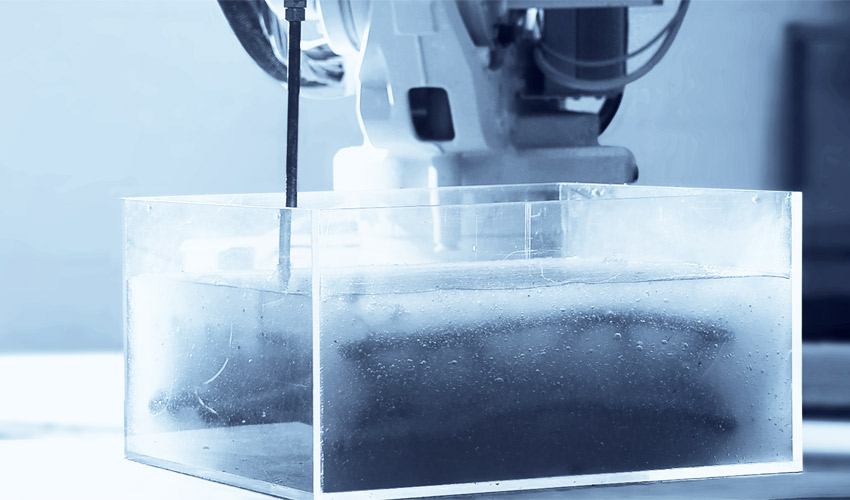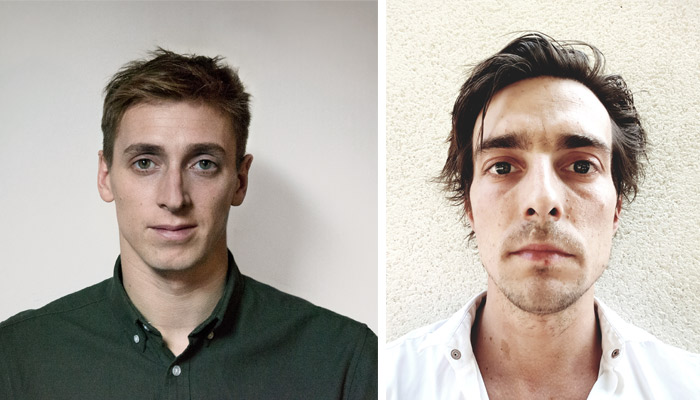Soliquid is the startup doing large-scale 3D printing in suspension

Soliquid is a French startup that has developed a unique 3D printing technology. Instead of depositing the material layer by layer on a tray, it extrudes it into a durable and reusable gel matrix using a 6-axis robot. The young company is offering a faster process that makes it possible to design complex parts, while saving material. Also, no printing support is necessary because it is the gel that holds the part whilst the material is being extruded. We met with one of the founders, Jim Rhoné, to learn more about this disruptive technology, how it works, its benefits and limitations.
3DN: Can you present yourself and your link with 3D printing?
Launched in Paris in 2018, Soliquid is a startup that specialises in additive manufacturing and develops a unique large-scale 3D printing process in suspension in a reusable and durable gel matrix. Amaury Thomas and myself are architects, we specialised in computational design and robotic manufacturing. The company Soliquid was founded together with Impulse Group – the objective was to broaden the field of 3D printing by proposing innovative logics and processes for the production of non-standard, tailor-made, complex and unsupported elements for multiple industries.

The founders of Soliquid, Jim Rhoné (on the left) and Amaury Thomas
3DN: Can you explain to us how your technology works?
Our patent pending large-scale suspension 3D printing technology differs from “layer by layer” 3D printing in that the printing material is deposited in a gel matrix rather than on the previous printing string.
The general device consists of a printing tray that contains a gel matrix and a 6-axis industrial robot, at the end of which is fixed the print head we are developing. This set consisting of the robot and its end-effector is directly controlled on a computer. It’s on the computer that the printing phase is prepared and then initiated: the 3D model of the element to be printed is analysed, adapted if necessary, then converted into 3D curves corresponding to the future toolpaths of the robot during printing. This path is then broken down into a succession of planes in the XYZ space and associated with certain parameters that define the specifications of the movement and printing processes. The software we use allows us to convert this data into RAPID language, used to control the robot. All the printing characteristics such as the toolpath, the robot’s movement speeds, but also the start/stop of the print and the variations in its flow rate are therefore programmable.
In parallel, a pump is used to bring the printing material from the storage and mixing tank to the print head. When printing starts, the print head fed by the pump plunges into the printing tank and deposits the printing material following the previously determined toolpath. This is where the specificity of our technology comes into play: rather than casting, the printing material is kept in suspension in the matrix, thanks to a clever balance between viscosity and density in the materials used.

The 3D printing process put in place by Soliquid | Credits: Soliquid
At the end of the printing phase, the element is kept suspended in the matrix, thus acting as an adaptive formwork/mould/support, until its solidification, or hardening, is sufficient to allow its removal from the tray. Once the part has been extracted, a new print can be done in the same tray; the stability and durability of the printing matrix allows the process to be repeated many times over long periods of time with the same initial volume.
3DN: What materials do you use?
At the beginning of the Soliquid adventure, the first demonstrations of our small-scale process were made with two-component sealing resin. During the R&D phase we chose to use a material widespread in the construction sector, concrete. More precisely, we use HPC, BTHP and BFUP, whose compression, traction and bending performances allow us to produce the wire structures, meshes and 3D meshes while maintaining a satisfactory structural behaviour.
During this first phase of R&D, which enabled us to carry out a POC and various large-scale demonstrations, we worked on characterisation of materials compatible with our technology. The main constraint therefore remains the ability of the material to exist in a liquid form for the printing phase, and to solidify in an anaerobic environment by internal reaction, initiated without external energy input. The latter therefore allows the use of many products with extremely varied properties such as resinous concretes, silicone, one-component or two-component resins, or even certain mastics, polymers and composites, the use of which is already industrialised in many sectors. Since the injected material is kept in suspension until it hardens, this printing process also allows the use of several materials for the same element, with the possibility of printing directly into multi-materials or of printing successively with materials of a different nature.

The robot is extruding concrete | Credits: Soliquid
This research in materials science and engineering, carried out at the same time as the development of our technology, therefore encourages innovation. We intend on working on the formulation of new materials capable of responding as well as possible to the various constraints, adapted to the diversity of applications envisaged and giving priority to the use of biosourced components or those resulting from recycling and reuse processes.
3DN: Which sectors are you targeting?
The initial and main objective of Soliquid’s creation was to develop our 3D printing process in order to revolutionise prefabrication in the AEC (Architecture, Engineering and Construction) and Design sector, by proposing a new industrial production method for constructive, complex and custom-made elements, lighter and more efficient, without the use of moulds or supports. With this process, a wide variety of applications can indeed be imagined and are beginning to emerge. They range from the optimisation of structural systems (slabs, columns, beams, building modules…), to the manufacture of non-standard architectural elements (façade panels…), to the production of innovative furniture ranges. Aware of the long time frame of this type of process, mainly related to normative aspects and certification and regulatory issues, we have chosen to target other sectors also.

The technology developed finds applications in the architecture sector | Credits: Soliquid
Among them we are targeting the ecological industry and more precisely the production of sustainable engineering solutions is becoming one of our preferred activities. Indeed, in response to new challenges facing our societies, such as the erosion of biodiversity and the degradation of ecosystem services, the combination of engineering and ecology aims to contribute to the resilience of fragile ecosystems and to sustainable development through the design, application and management of processes, products and services to prevent, limit or repair environmental degradation. For several years, projects have been integrating ecological engineering into the eco-design of marine elements in the form of artificial reefs or cladding modules. These devices, which are supposed to create artificial habitats for fish and shellfish and stimulate the development of biomass, are based on biomimetic solutions and are therefore often complicated to implement. The Soliquid 3D printing solution, by allowing the production of elements with complex and organic geometries (three-dimensional mesh, tree structure, bridging, cavities…), is therefore extremely well suited to printing such elements.
Finally, the medical sector is also one of the fields of application we are considering, in particular for the manufacture of custom-made devices, prostheses and orthoses adapted to the user, ultra-light, resistant and printed in an extremely short time.

Structure printed by Soliquid | Credits: Soliquid
3DN: What are the benefits of this technology? Have you faced any limitations?
Many players in the construction and building sectors are now trying to adopt additive manufacturing technologies as a production strategy. To date, however, the latter play a very limited role in industrial processes, for four main reasons: production time, scalability of the device, material and formal limitations.
With a unique concept, the process we are developing responds to the challenges raised by existing additive manufacturing techniques with three major differentiations: printing speed, morphological (design) freedom and material saving: using a gel matrix to keep the printed material in suspension, our printing strategy does not require any support materials. The material can therefore be continuously injected without requiring its progressive solidification during printing, making the printing process extremely fast. We are not restricted to the ‘layer by layer’ feature of most 3D printing techniques, therefore we can allow extremely free toolpaths in terms of direction and orientation of the extruder in the 3D space. Thanks to the topology optimisation tools we use, the printing of an element can be programmed to be optimised in three dimensions and at different levels: material quantity reduction, carbon emission reduction and structural performance. Our suspension technique also makes it possible to consider new printing possibilities, which are difficult to implement with conventional 3D printing processes. For example, parts can be printed according to intricate principles (e. g.: one inside the other, chain links connected to each other, etc.).

Our technology allows shapes created to be entangled | Credits: Soliquid
Finally, the stability and durability of the printing matrix contribute to the reduction of the overall quantity of material needed for our process. In addition to its environmental friendliness, the reusability of the matrix was one of the essential criteria for the successful development of our technology. After the extraction of each printed part, a first cleaning allows to recover the main part of the gel in order to limit the losses and to be able to proceed to other 3D printing jobs with the same initial volume. A second wash then removes all traces of gel from the printed part, mainly for aesthetic, finishing and handling reasons.
From a technological point of view, the main challenges encountered during this first year of development were mainly related to questions of scalability of the technology. As well as the use of new materials with densities much higher than the resins initially used. Now that this validation phase has been completed, we are looking to conquer new applications and new markets with such a disruptive process.
3DN: What are your future projects?
Unfortunately, little information can be provided about our future projects, except that they will be implemented by the end of 2019 and appreciated by their users, both submarine and land-based. Follow us on the social networks to make sure you don’t miss any of our news.

Credits: Soliquid
3DN: One last word for our readers?
Soliquid remains a dynamic and fast-growing young startup, in which the possibilities of research and development in the fields of hardware, software and materials engineering are unlimited. We aim to design ever more efficient 3D printing hardware technologies and software solutions and remain convinced that the unique process we are developing will emerge and contribute, alongside other complementary devices, to the creation of new production strategies in many industries. With this vision in mind, we position innovation at the heart of the company’s DNA, which is essential to the continuous improvement and optimisation of our process. If you are interested in being part of the adventure or think that interesting synergies can be created between your business and ours, do not hesitate to contact us.
What do you think of the Soliquid technology? Let us know in a comment below or on our Facebook and Twitter pages! Sign up for our free weekly Newsletter here, the latest 3D printing news straight to your inbox!







